|
FAQs about Faviid Coral
Behavior
Related Articles: Faviid
Corals,
Related FAQs: Faviids
1, Faviids 2, Faviids 3, Faviid Identification, Faviid Compatibility, Faviid Selection, Faviid Systems, Faviid Feeding, Faviid Disease, Faviid Reproduction/Propagation,
Stony/True Coral, Coral System Set-Up, Coral System Lighting, Stony Coral Identification, Stony Coral Selection, Coral Placement, Foods/Feeding/Nutrition, Disease/Health, Propagation, Growing Reef Corals, Stony Coral Behavior,
|
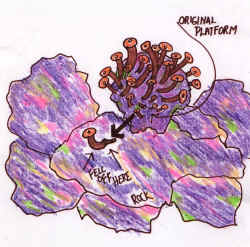
|
|
Why won't my candy cane inflate?
3/29/11
I've had my candy cane (Caulastrea) for 6 months. It opens,
but never inflates all the way, and I'm trying to figure out
why. The attached picture shows the maximum it will puff out.
<Looks good to me here>
It opens during lights-on & closes after lights-off, puts out
feeder tentacles (when open as well as when closed); when I feed
it the heads close in a smooth, sphere-like shape which I presume
means it's digesting (does this for mysis & Oyster Feast,
but not Cyclopeeze). Since I've had it one head has split in
two and another is in the process of splitting. In general it
looks healthy.
<It does to me as well>
So why won't it inflate? I've been trying to eliminate
possible factors:
- Light. It's under a PAR 30 LED, but for the first 6 weeks
was under 9w CF so it's been the same under high & low
light.
- Flow. It's in gentle flow, which I'm told is
appropriate.
- Water chemistry. I do a 100% water change
<I would not do this... a maximum of thirty percent is
generally the most... See WWM re. This is very likely
problematical>
every week using ESV B-ionic salt, so all the trace minerals,
etc. get reset. I also dose w. a 2-part ionic supplement
(C-Balance).
pH = 8.2. Ammonia, Nitrite, Nitrate = 0. Phosphates = 0-0.1.
- Pests. Have never seen anything on it.
- Allelopathy. This was my sixth coral, the others being a ric,
and small frags of Zoas, Palys and cloves. I've since gotten
other corals, but it was already uninflated with the initial
crew.
<Could be allelopathy to some extent here>
- Space. I've been wondering if they have a way of sensing
how much space is around the heads before inflating? While it
does have room to inflate, it would be almost touching the tank
wall and rock. Unfortunately, I don't have another place to
move it that isn't higher light & flow than I think it
wants. One week I accidently had it too close to the glass and a
couple of heads smooshed when they opened, but they opened
anyway.
I know other reefers who have fully-inflated candy canes in the
same 3 gallon tank as mine, and with 10 times the amount of
livestock.
I'm out of ideas. Would appreciate your thoughts, and let me
say I've gotten tremendous value out of reading your site and
thank you for sharing your expertise.
Kathryn
<Of what you list, and what typical "causes" I'm
familiar w/, I think the 100% water changes are most influential.
This being stated, I would not be overly concerned re this
Faviids behavior. The facts that it eats, has asexually
reproduced... Bob Fenner>
|
|
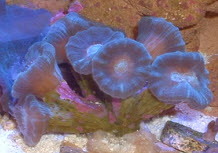
|
|
Pineapple Brain Excreting? (Egesting,
actually'¦) -- 10/03/10
Hi there,
<<Hello Vijay>>
Have a very new reef setup with no fish but only some inverts.
It's been running for the last one month only.
<<Okay>>
Have had a couple of pineapple brains for the last week and
feeding it crushed/ground fresh cocktail shrimp twice a week.
<<Excellent>>
Today noticed that the brain was excreting (?)
<<Yep)
brown slime from each of its mouths. Attaching a photo of the
same.
<<Ah yes, I see--does appear to be a Faviid, and a good
looking one too!>>
Almost all the mouths did excrete this brownish slime over a half
hour period. Then everything got cleaned out with the current and
it's back to normal. The brain did shrivel back during and
after the excretion (?).
<<Yes, typical'¦>>
What is it?
<<Waste products (and a sign your feeding regimen is
adequate here)--or maybe even just excess
Zooxanthellae>>
Is it OK or is my brain sick or something.
<<The 'mouths' serve for both ingesting food and
egesting waste. Your coral is just fine>>
Cheers,
Vijay
<<Happy to share'¦ EricR>>
|
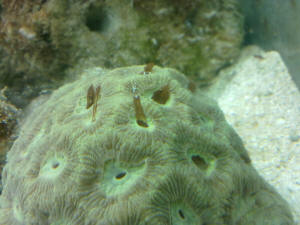 |
|
Coral Splitting? 3/15/10
Hi Bob,
<Big J>
I have a Caulastrea (Candy Cane) where the skeleton is actually
splitting down the middle. This happened over a period of three
days. The original appearance was uniform, more like a ball.
Wondered if you have ever witnessed anything like this. See
attached pic.
Cheers,
James
<Neat... have seen a bunch of Cnidarians doing this sort of
breaking up over the years... in captive and wild settings. Nice
Demoiselle BTW. Cheers, BobF>
|
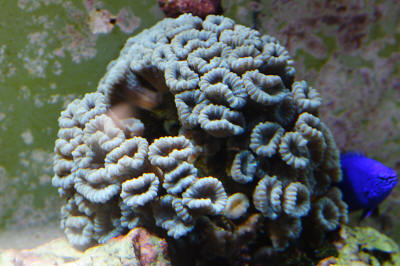 |
Re: Coral Splitting?
The Yellow Tail Damsel is not camera shy for sure, very nosy.
James
<A good quality I'd warrant. B> |
|
Shiny threats between rocks. Caulastrea beh.
2/24/10
Hi, I added a piece of rock with a mushroom on it to my aquarium
about a week ago. I placed the rock next to my candy cane corals,
with the single tiny mushroom about 3 or 4 inches from the candy
canes. You can barely see the mushroom on the end of the rock in
the 2nd attached picture. Anyways, now there are these shiny
fibers attached between the rock and a candy head that has been
dead since I purchased the coral some months ago.
<Likely there is some live tissue here>
The fibers are coming out of a small indentation in the rock, but
I cant see any sort of creature at the end of them, as the hole
they go into is just barely too dark. I don't want to move it
and break the threads if they happen to be something good, but
I've never seen anything like this in my tank before and was
curious to see if you could possibly help me figure out what is
going on and whether I need to do anything about it or not. The
fibers are a clearish/whitish color and are very shiny when any
lights are on them. They don't move at all so I doubt they
are any kind of worm or tentacle, but they have appeared to be
growing very slowly over the past few days. I don't want them
to progress and possibly take over my candy canes, but I
can't tell whether they are potentially harmful or
not. My water quality is fine, with nitrites and ammonia at 0 ppm
and nitrates just above 0. Calcium levels were somewhat high last
time I checked, but all my corals I've put in so far seem to
be doing great.
Salinity is at 1.024 and temperature is about 78. I see good
polyp extension during the day and most of my candy canes have
feeder tentacles coming out every night, so it doesn't seem
like anything is being bothered just yet. I just added a chalice
yesterday that also seems to be doing well. So I'm just
hoping that these strange fibers aren't going to start
killing off my corals. Any help would be greatly appreciated as I
am completely stumped on this one. Thanks.
<The coral is "reaching out", testing the area about
it to see/detect other competing life... Read here please:
http://wetwebmedia.com/cnidcompppt.htm
Bob Fenner>
|
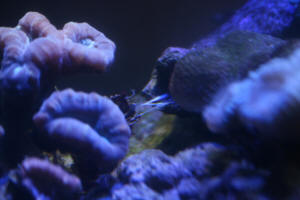 |
|
re: shiny threats between rocks --
02/25/10
The threads aren't coming from any living coral tissue
though. Is the coral somehow producing these through the dead
skeleton?
<Yes. "... some tissue">
Also, does this mean that the coral might grow a new head or
something in that direction if it seems suitable?
<Indeed>
More information regarding what this "reaching out"
process is all about would be very helpful. The link you sent me
seems to talk mostly about coral competition through toxins or
physical contact, but there wasn't really anything about
corals detecting others around them through the use of such
fibers. The article mentioned how to prevent competition and so
forth, but my corals aren't harming each other at all. I am
well aware of the devastating effects of sweeper tentacles and
nematocysts, but the 2 corals are too far away for the regular
nematocysts to have any effect, and I have never observed any
sweeper tentacles coming from any of the corals in my tank, and
these threads are clearly not sweeper tentacles.
<They are not, assuredly>
The threads also do not appear to be any sort of digestive fibers
that corals sometimes use to consume neighbors, as they are not
touching any other corals and are not coming from any living
tissue. Their location suggests that the threads are coming from
some other organism besides the corals, unless corals are able to
produce these from skeletons that have been dead and without
tissue for over 6 months. Either way, more information regarding
the process of detection of other corals rather than how they
kill each other would be appreciated.
<Thank you for your understandable further input. I do think
there is a bit of live tissue here, "reaching out".
Time will tell. BobF>
re: shiny threats between rocks
Interesting. Ok well thanks for the help. I guess I will wait and
see what happens as you advised. Good to know that you think
there is actually some live tissue there. Hopefully the coral
continues to spread. Thanks a lot.
<Welcome. B>
|
|
Faviid weirdness question 11/3/09
This is a picture of a Favia coral I received from a reefkeeping
friend who had left it for an extended amount of time under poor
lighting (T5 white fluorescents). He actually gave me 3 frags
total, 2 appeared to be frags of the same original organism. Both
were lightly colored when I received them as you can see in the
picture, but one frag recently (within the past couple days)
developed this weirdness.
<?>
That middle area is scarlet red. It almost looks like skin peeled
off the middle area to reveal scarlet flesh, but I probably have
not described the phenomenon accurately. My friend tells me the
two pieces were originally
red but I have no picture of their original organism and this
looks rather odd to begin with.
Apologies for the blurry photograph, it was taken with a cell
phone as my regular camera batteries are charging.
Any ideas what's going on?
<Bleaching likely. I'd be reading re the captive
requirements of Faviids; particularly nutrition. Bob
Fenner>
|
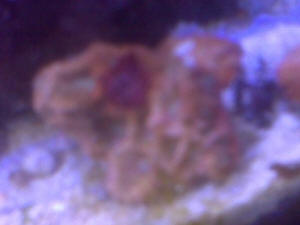 |
Re: Faviid weirdness question
11/3/09
I did some perusing of the WWM faqs on bleaching and diseases on
Faviids and I didn't see anything that looked like this.
These pieces have actually been in my tank a couple weeks now, they
were originally under a small fluorescent light fixture (3:1
white/blue mix), now they're in a much brighter tank with (3:2)
blue/white mixed LED lighting,
but I'd thought any bleaching as a result of light changes
would have taken place sooner.
<Possibly... there are other causes than light quality,
intensity, duration>
Could you explain your thought on this? I'm fairly new to the
hobby and I don't really follow.
<... Please read re Scleractinian keeping period... there is too
much to go over re water quality issues alone. Suffice it to state
that if conditions are more favorable in your setting (and not on
the sand...), these colonies
should improve with time. BobF>
Re: Faviid weirdness question
Also, I've been feeding phyto and mysis shrimp in the tank on
recommendation from the friend and WWM faqs.
<... keep reading. B> |
|
Melting Platygyra and identification 02/09/09
Hi Boys and Girls, I love the info you make available on this
site, however I have difficulty finding answers even when
searches show results, I read through both linked archives
entirely twice, learned all kinds of stuff but not the thing I
wanted to learn. That being said I hope you don't mind
answering this question yet again. <Thank you and of course
not> I have a ~290g (tank+sump) that has been running for
about a year and a half. 50 L x 32 H x 32 D. As I only add a
little at a time we have about 210 lbs of live rock on the right
side of the tank. We have one 450W MH over that side and 4
actinics that run the length of the tank . Will eventually add
another 450 at other end before it becomes populated with corals
and such. We have heaters and Tunze skimmer in sump. Top up daily
and add Tropic Marine bio-calcium. We feed New Life Spectrum
Pellets early day and alternate nightly with frozen Spirulina
enhanced Brine Shrimp and Mysis Shrimp, 2 - 3 times a week we add
an ounce of DT's Phytoplankton and alternate days Cyclopeeze.
All chemical tests are in good to excellent range, Nitrite,
Nitrate and Ammonia are 0, etc. Inhabitants include 5 blue
damselfish (blue devils) 1 male, 4 females 1 six line wrasse 1
blue green chromis and 1 clownfish (false) 1 sea hare, rather
large 6-7 inches long (wasn't when we got it, 2.5 inch) 5
shrimp, 1 blood, 3 cleaner and 1 peppermint 25+ each, hermit
crabs and snails Ricordea, Rhodactis and Discosoma mushrooms, in
blue, green, green stripe and spoted, red, and orange Frogspawn
Elegance Lg BTA that has split and now has smaller sibling 2
Clams 1 LG (volleyball size when fully open, about 11 in) and 1
smaller (4 in) 2 Fungia (1 Orange, 1 Green) 1 Blastomussa 1
Symphyllia 1 Platygyra 1 Green Star Polyp (weed in my setup
slowly trading for other things) 5+ pieces candy coral Anyhow, we
had a large infestation of flatworms, and thought to syphon out
as many as possible. Dummy, (that would be me) didn't think
and syphoned through a screen putting water back into tank.
<yikes!> It never occurred to me that I was going to poison
my tank ( I now know better). <good> I lost all 3 Tangs,
yellow, blue and purple along with the flatworms. <?!> At
this point everything else was not looking so good so we moved as
much as possible to a 30g that was running upstairs while waiting
for toxin to clear up with carbon. Figured we had nothing to
loose and decided to go ahead with a treatment of Flatworm Exit
from Salifert. Seems to have worked great, my sand is white
again. Ran carbon for 5 days before moving everything back.
Everything seems to have recovered, but my Lg. Anemone decided to
shift about 6 inches from where it has been for the last 10
months, bringing it too close to the Platygyra. I moved it up and
over about 8 inches. Now it appears to be melting. Is it possibly
damaged or hurt from Anemone? <It is dropping polyps (a form
of asexual reproduction). This is not necessarily a bad thing.
It's actually pretty cool.> Or does this coral propagate
in this way. <one way, yes, bingo> Please see attached
photo. Also at the same time could you possibly identify a few
things from these 2 photos as well. The polyp just under the
Platygyra is a pest <I can't see much in the photo (thank
you for labeling them though), but they look like hydroids.>
that has been showing up all over my tank but I don't know
what it is and the other coral above it in the photo I forgot to
write down and the LFS doesn't remember that particular
purchase and can't tell me. <I do think they're pest
hydroids (my guess):
http://www.wetwebmedia.com/hyzoanidfaq.htm> In the other photo
there are 2 mystery coral, one encrusting and one that is
actually the live rock skeleton that survived and another pest
that I have been trying to eradicate to no avail. <The one
encrusting looks like it might be Montipora, but I really
can't tell from the photo. I'm sorry, but the other one
is also just too difficult to make out. Do you think you could
take and send better pics?> Keeps coming back all over the
tank, grows like a plant. The last photo is just entire right
side just for visualization. Thanks so much for your help in
advance. Christine <De nada,
Sara M.>
|
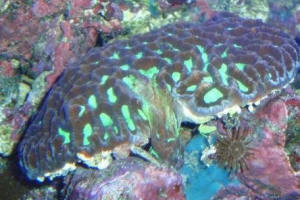 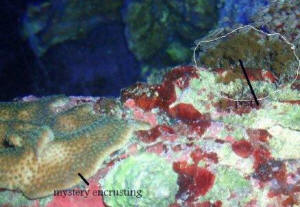
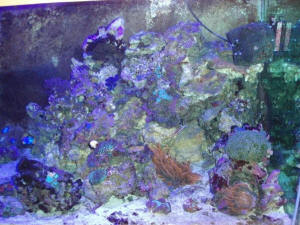 |
|
Coral behavior & matching shrimp
goby symbionts 02/06/09 Hello! Starting with the usual
but not just perfunctory greeting: You folks are a great resource
to hobbyists, thanks for all of your time and efforts. <Ha!
Thanks.> I have a plate type coral (for well over 10 years),
Platygyra sp or perhaps Leptoria (phrygia?) as near I can tell. I
noticed last night after lights out that it had
swellings/extrusions from many places on the coral. I may have
just missed it in the past, but I have never noticed this before.
I have attached one zoomed pic, and there are 3 other pics at
this link (not attached due to size):
http://www.phpwebservices.com/fritz/gallery/main.php?g2_itemId=4131
Are those just mouths and feeding tentacles? Or is it doing
something else? <They are something like mouths/stomachs and
feeding tentacles in one... something called "mesenterial
filaments." They are digestive structures that a coral can
sometimes extend to either feed or attack (or both).> Second,
very minor question. I have a Cryptocentrus leptocephalus and I
wish to locate a shrimp to go with it. I searched and can not
find the species of shrimps that these fish normally pair with. I
wish to keep my biotope of Western Pacific. Can you help me out
with some suggestions? <It's probably easier to search for
this pairing on FishBase: http://fishbase.org/search.php>
Thanks for any and all help. Much appreciated. Helmut Fritz
<De nada,
Sara M.>
|
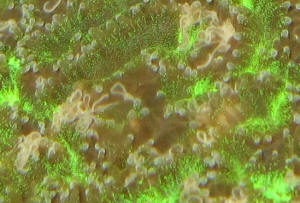 |
Candy Cane... Normal Polyp Extension 3/17/08
Crew.... <Hi Diane and Michael, Mich here.> As usual, thanks in
advance for your knowledge! <Happy to share!> Quick question ....
this morning the tank's lights were out but the room was bright
enough to see the Candy Cane coral. I have never noticed before, but it
looked like the coral was covered in tentacles ... little spikes all
around each head. Looks like the coral is covered in Aiptasia! <Is
not Aiptasia. It is the coral polyp extending to feed. This is
normal.> I did a search on the site for Candy Cane at night and
found one mention of tentacles ... is this what the coral is supposed
to look like? <Yup.> I can't imagine it's covered in
Aiptasia, since they are supposed to sting and hurt the coral and our
Candy Cane is huge and growing more every day. <Yay!> We are
curious (and had a few Aiptasia a month or so ago and perhaps are
inclined to imagine them where they aren't)!! <Is not Aiptasia.
More images here:
http://www.aquahobby.com/corals/img/Caulastrea_furcata_2.jpg
http://www.masla.com/images/caulastrea02.jpg > Dianne and Michael
<Cheers, Mich>
Re: Tiger Jawfish Keeps laying eggs, and unidentified
coral (Favites color Q) -01/29/2008 How can I bring back the color
of the Favites? The new mouths are very colorful is there any way I can
bring the color back to the old mouths that are bleached? <Just feed
it well, be patient... the color should return in time. Best,
Sara M.>
Question on Mushroom Coral and Candy Cane
Coral... a Fungia, not a Corallimorph 11/21/07 Hi, <Hi
Sammy!> I have this mushroom coral for 2 weeks now. <You have
a Fungia, occasionally called a mushroom coral, not a Corallimorph,
which is more typically called a mushroom coral. More here:
http://www.wetwebmedia.com/fungiidae.htm > It seems to bloom
only when the lights are totally off. <Yes, this is not
atypical.> Here are photos of it with the light on, with only a
flashlight, and lights totally out. <I see.> I currently have
it half way down the water column with medium water flow. Should I
move it down onto the sand <Yes, but be aware, these corals ARE
MOBILE. Yes, that right, they are capable of moving, even capable
of climbing! And their mucus can be quite toxic. So the Fungia need
to be kept at a distance from other corals.> or in a shadow from
the light? <In the light is fine.> Is this normal?
<Yes.> I also have a candy cane that is doing the same thing.
<This is normal. More here:
http://www.wetwebmedia.com/faviidae.htm > When I bought this
coral, it was quite bleached. It is not starting to get some green
coloring. <Good.> I have seen candy cane corals opening in
full light at the LFS. <Yes, some gradually accommodate.> But
mine will only open when the lights are off. <Again, not
unusual.> Is this related to that fact that it was bleached?
<Not necessarily.> What is the best thing I can do for this
coral? <Feed it at night when it is open, finely minced pieces
of meaty foods.> Move it to a very low light location?
<No.> Here are photos of the candy cane. <I see.> Flash
shot with lights off. <Came out pretty well for just being
illuminated with a flash light!> Thanks for your help.
<Welcome! Mich>
Sammy |
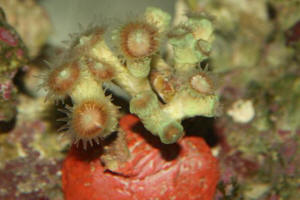 .jpg) |
.jpg) .jpg) |
Candycane skeleton disintegrating 8/22/06 Greeting
from Nova Scotia <Hello from San Diego, CA> I have a small coral
reef tank since 9 months that causes no troubles. One of mine
Candycanes got now about 11 branches (had 7 or 8 when we got it) and
it's doing really good (dividing, long tentacles at night, bright
colours, etc...). Two days ago however, I noticed that 2 of the
branches are actually disintegrating. I am talking about the skeleton
at the back of the polyp, and surprisingly enough, the polyps at the
end of those branches are looking awesome and do not seems to be
bothered at all. I am suspecting a lack of Calcium and/or the fact that
my pH might be a bit too low (7.8/8.0) <Could be more...> so it
drives the carbonate equilibrium of sea water toward the HCO3- side but
I am not sure. A friend of mine (has a big coral reef tank) said that
it might be the fact that my Candycane is submitted to water flow that
are two high. <Another factor> I doubt it, but do you have any
suggestions ? Thanks so much in advance Flavienne <Mmm, the
ultrastructure of the alkaline earth skeletal matrix is likely
"missing" something... happens frequently with (your as
stated) imbalance of calcium, magnesium and alkalinity... Do you have
the "Kalk habit"? This is a common situation (soft skeletons)
with this use... other methods of supplying ready alkaline earth,
carbonate produce "harder" bio-matrix (calcium reactors, two
part supplements...). Bob Fenner>
-------------------------------------- Dalhousie University Department
of Oceanography
Candy Cane Coral...Turn Off Your Brights -
05/19/2006 Hello WWMC !! <Hello Esteban> Always a pleasure to
have someone to send an e-mail too that will guarantee a great
response! <Thank you.> I have had a nice colony of about 15 1
inch pink Caulastrea (trumpet coral) <Caulastrea curvata> about
halfway vertical up my 125 gallon and half way horizontal in the tank.
I was using two 175 watt MH's on for 10 hours and two 6 foot blue
HQI actinic bulbs on for 12 hours (1 hour on before the MH turn on and
1 hour after the MH shut off) for about 3 months. The colony would come
out beautifully - which after my reading I am guessing was because it
was reaching out for more light. Well, I switched the MH's to two
250 MH's running for 10 hours, and the same 6 foot bulbs running
for 12 hours. That was last month. About two weeks ago, I noticed that
the heads of the coral were not as expanded as before. They will come
totally out for an hour or so in the middle of the 10 hours, then close
back up. Their tentacles still come out when I am feeding the tank.
I'm worried that something might be wrong? The water levels are
still consistent with No ammonia, Nitrite, PH 8.5, nitrates around 40,
calc 440, 1.025 SG. I have not changed my usual dosing of iodide,
C-balance, Reef Calc, Reef Plus, Reef Complete or Magnesium. Should I
consider moving the coral lower in the tank? Is it getting too much
light? <I think they are going through a light adjusting period with
the more intense lighting. These corals only require moderate light and
they generally do not open their feeding tentacles until the lights go
out. My Candy Cane <furcata> has never opened during the daylight
photoperiod. You may want to try putting them in the lower level of the
tank to encourage opening.> Thanks mucho! <You're welcome.
James (Salty Dog)>
Candy cane coral growth, system 7/14/05 Hello to all,
it's been awhile since I have posted a question, I have a large
colony of candy cane coral about 3 years in my tank. The colony has
about fifty heads and is growing well, however over the last month or
so I have noticed an unusual growth pattern. Certain heads appear to be
growing together where the tissue touches forming what looks like a
bubble that eventually covers both heads. Nothing in the tank has
changed except my upgrade to a Deltec calcium reactor. <Ahh!> As
of 7/11 my parameters were Alk 10.2, Cal 420, PH 8.0-8.2, Mag 1330,
Temp 78-80. The coral is mid way up in my tank with good flow and under
(not directly) 250 watt HQI lighting. I am concerned about this coral
as it is the only coral that appears to have this issue. Is there
anything I can do? <Mmm, nothing you have to do...> Could this be
an indication that fragging is needed? <Not needed...> Thanks
Mike Winston <You have a situation of "natural
development" in your aquarium here... with this Faviid,
conditions... you can break it up, move parts elsewhere, but the growth
you describe so well is to be expected, given the conditions you're
providing. Bob Fenner> Re: Candy cane coral 7/14/05 Thanks
for the reply, can you explain what you mean by "natural
development" Thanks again. Mike <Will try... but the adverb
"natural" throws me... The coalescing growth you mention is a
foregone conclusion... given aquarium lighting, the abundance of
calcium, balance with magnesium, alkalinity in a stable, less-than
(here's that word again) natural circulated environment.
BobF>
Open brain coral, Shrinking open brain coral? Hi guys, sorry
to bother you, but the chatroom couldn't answer my question about a
green open brain coral. <no bother at all, Anthony Calfo in your
service> This coral has been in my tank for about 2 months. It has
been healthy and fully expanded at all times. Yesterday I looked at it
and I could see its skeleton. It was totally deflated. It still has the
green coloring, but you can see all the hard plates. <called
septa> What could happen in 8 hours? <little that wouldn't
affect other coral/fish. You simply are observing the animal perhaps
after it has passed a threshold... more below> water parameters are
normal- same as they have been since I got the brain. Nothing has been
added or changed in/or to the tank. No other inhabitants have been
affected fish, anemone, mushrooms starfish, polyps etc....) Today, I
picked it up to see if something had damaged it from the bottom sits on
sand bed) nothing. It didn't smell, so I assume its not dead. I
replaced it in the same spot, and checked that the powerheads were not
blowing on it. Do these corals take a break sometimes, or is something
seriously wrong? Thanks Chantillylace <although a cycle of polyp
extension is quite normal with this and many LPS coral species... the
problem of attrition is quite common with this animal in captivity. By
some measures, this animal can only satisfy its daily need for
food/carbon by 2/3 through the products of photosynthesis. That boils
down to the animal needing to be fed almost daily and certainly weekly
in captivity. If you haven't been feeding it much or at all, that
is easily the culprit. Food should be meaty (zooplankton substitutes)
and fine (1/4-1/2 inch... no chunks!). Do search the WWM site and
message board archives for like posts on coral feeding. Kindly, Anthony
Calfo>
I don't think the brain Coral was pooping..... Hello Bob
or Anthony, <Anthony Calfo in your service> So, here's my
problem, I've had my Faviid Pineapple brain for about 3 weeks now
and I don't think its doing so well, just to refresh, I've got
a 25 gal mini reef, LR LS, with a eclipse hood, with a 32w PC 1/2
daylight, 1/2 actinic, the brain is about 12in from the light,
<needs to be higher in the long run under these modest lights...
remember, the Blastomussa sp "Pineapple brains" are low
light, but the Faviids tend to be quite high>> with a bicolor
blenny, and Firefish goby, also have yellow polyps and green button
polyps that are doing terrific, and some mushrooms that are doing well
too. recent explosion of worms all over the place and a LOT of baby
brittle stars. <very nice indeed> So, the brain looks like its
receding on one edge right now, and maybe on one other, I noticed when
I put it in the tank that during the first week it looked like it was
pooping, expelling some brown stringy stuff, but it hasn't done
that since, <either excrement or packets of zooxanthellae and since
you having reported any loss of color (so-called
"bleaching"), we are still betting on the poop> and the
mostly all of the polyps are still a bright green, with brown ridges
around them. Every night it still puts out a bunch of feeding
tentacles, and there is a filter feeder of some sorts living in the
middle of the colony. <many common creatures embedded... barnacles
(shiny pulsing threads kicking out from crevice)> Now, I did notice
a spike in my nitrates from 0 to 5ppm, and I've been having a
little trouble maintaining the alkalinity since I put the coral in the
tank, though the calcium is still at 450 ppm, and ph is at 8.4,
<very fine> I'm having trouble keeping the alk at 3.5 meq,
right now when I just tested it was at 2.2, <yes, indeed low> so,
I'm going to add some more supper buffer. I've been
supplementing with Iodine and Strontium, but this coral doesn't
look as nice as when I got it 3 weeks ago. What could I be doing wrong?
<the lights aren't bright enough for starters... moving up will
help some> I stopped feeding Mysis shrimp everyday and cut it back
to every other day, <yikes... will die faster this way with weak
illumination too... needs carbon from food not produced by symbiotic
algae under weak light> and I only fee like half a cube, not to much
flake food either, <flake food is inappropriate in this case> and
a changed the filter pad and stuff to reduce the nitrates, Any
suggestions? <again... keep small frequent feeding and move within
6" of surface> David <best regards, Anthony>
Re: I don't think the brain Coral was pooping..... Thanks
Anthony!, <very welcome, David my friend> I'll try moving the
brain up closer to the light, I'm definitely going to have to get
more LR for my tank, make the base higher. <LR is always a good
investment in the tank> I'll cut the cubes in 1/3s, problem with
my feeding, <remember...very fine/shredded food is necessary. Cube
foods are often gelatin based and hold together in a large and hard to
digest chunk.> is that the brain doesn't put out the feeder
tentacles until about 1-2 hours after the light goes off, is there a
way to convince it to do this earlier? <yes, take the thawed pack
juice from frozen meaty foods (that is generally discarded for fear of
contributing to algae in the tank) and put a spoonful as an attractant
into the aquarium prior to feeding. After 15 minutes or so, the feeding
tentacles will usually come out. Shrimp type prey (cocktail, mysids,
krill, etc) usually works best for this.> or, should I just
concentrating on feeding twice a day, once for the fish and the yellow
polyps, and then again once the feeder tentacles come out? how does
that sound? Thanks!!! David. PS. yea every night when the lights go out
more and more things come crawling out of their wholes, its rather
amazing, I just can't get over all the brittle stars, is there a
microscopic variety of them? <yes... and livebearing/fast
breeding> or are these really baby's of the bigger variety?
<nope...very unlikely> I'll tell you the Firefish is enjoying
it, I caught him/her (that's why we named it Lola) trying to get
down a leg yesterday! <hehe...got to love it. Tell Lola to crunch
all he/she wants... they'll make more <wink>. Kindly,
Anthony>
Coral Questions Hello, it's Ari again. All's well
with the tank. Crabs are molting, fish are loving life and getting
along. Corals are all coming along beautifully. Currently, my 25 gal.
reef has the following: clean up crew, sally lightfoot, emerald crab, 2
starfish, strawberry Pseudochromis, yellow watchman goby, Banggai
cardinal and flame angel. Corals are 1 green open brain, bubble,
frogspawn, mushroom, trumpet. All levels are in check and water is
crystal clear. All organisms thriving. My question is about the green
open brain. Yesterday it did something that perhaps it does each day
but this was the first I'd seen in 4 weeks of ownership. All of a
sudden it got very thin -- you could basically see the skeleton and
then it opened each of its three mouths and blew red waste into the
water. At least I think it was waste. Is this normal behavior? Last
night it was feeding with all tentacles out and this morning it is
great. I've just never seen this before. Is that how it excretes
waste? I'm thinking that it must be b/c the starfish immediately
came out from under the rocks and both of the were all over it. Any
help would be great. <You are right, it sounds like normal waste
excretion.> Also, could you tell me if I'm reaching my maximum
fish load. I'd love a long-nosed Hawkfish. <You are definitely
pretty full already.> Thanks, and GREAT BOOK. Ari <You are quite
welcome. I know Anthony and/or Bob will enjoy the compliment. -Steven
Pro>
Closed Brain Bubble- 5/28/03 Thanks to Anthony, the
"doughnut surgery" on my overgrown toadstools was a success,
the patients are fine and children were born. [trimming the perimeter
of Alcyoniids to control growth] <excellent to hear, my friend! If
you took any pictures, please share them with us> My closed brain
coral has done well for two years with little growth, but it seems
healthy with the green pockets brightly colored glowing under the blue
actinic. Lately, I see two bubbles growing along its bottom edges, one
is over an inch, the other about 1/2 inch. They are somewhat
transparent and have a green spot on them. Should I be concerned or be
doing anything? <hard to say... could be a couple things... leaning
towards bad: a change in lighting (usually an increase from cleaned
bulbs/lenses or new lamps) can cause stress induced polyp bailout
symptomatically similar to what you see. In other cases, it is caused
by aggression from an aggressive neighbor nearby or touching> There
are two large polyp colonies on either side of the brain. Perhaps I
should remove some of them. <Hello! neighbor> I have too many
polyps in my system but haven't come up with a method to remove
them other than pulling them off the rock one at a time with tweezers.
Any suggestions? <yep... diagonal pliers that bite the rock at their
base and skin them off the substrate with a slight sliver of rock
underneath. Much faster and less damaging (fear of the polyps exuding
palytoxin that harms the coral or you (!) over time from you tugging on
their heads with tweezers <G>> I do have a green globe urchin
which stays busy eating coralline algae, mostly off the back of the
tank where it is thick. He has never been seen near the brain or other
SPS corals. <no worries... not suspected> My water chemistry
remains perfect with nitrates usually un-measurable and ORP between 300
and 350. Ca at 350 to 400.Temp.is chiller controlled at 78F. Even with
R/O, D/I, ozone, macro algae refugium, less than 1/2 the recommended
bio load, regular bulb replacement, and weekly 10% water changes I
still have more than my share of red and brown algae. I conclude that
this is something that must be lived with. Do some people really live
without it? <possible... all about nutrient control. No nitrates
does not mean no nutrients. Just none that you have a test kit for ;)
The skimmer is the key. That and strong water flow (towards 20X)>
I'm off to Cozumel for a family diving trip with a new digital
camera and case. Does Bob use the "white balance" settings?
<not sure... I thought he mostly used Tequila to get the best
shots> Howard in Wisconsin
<Antoine in space>
|
|

